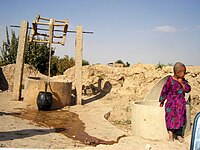
Photo from wikipedia
Uranium (U) is one of the typical naturally occurring radioactive elements enriched in groundwater through geological mechanisms, thereby bringing about adverse effects on human health. For this reason, some countries… Click to show full abstract
Uranium (U) is one of the typical naturally occurring radioactive elements enriched in groundwater through geological mechanisms, thereby bringing about adverse effects on human health. For this reason, some countries and the World Health Organization (WHO) regulate U with drinking water standards and monitor its status in groundwater. In Korea, there have been continuous investigations to monitor and manage U in groundwater, but they have targeted only public groundwater wells. However, the features of private wells differ from public ones, particularly in regard to the well’s depth and diameter, affecting the U distribution in private wells. This study was initiated to investigate U concentrations in private groundwater wells for potable use, and the significant factors controlling them were also elucidated through statistical methods. The results obtained from the analyses of 7036 groundwater samples from private wells showed that the highest, average, and median values of U concentrations were 1450, 0.4, and 4.0 μg/L, respectively, and 2.1% of the wells had U concentrations exceeding the Korean and WHO standard (30 μg/L). In addition, the U concentrations were highest in areas of the Jurassic granite, followed by Quaternary alluvium and Precambrian metamorphic rocks. A more detailed investigation of the relationship between U concentration and geology revealed that the Jurassic porphyritic granite, mainly composed of Daebo granite, showed the highest U contents, which indicated that U might originate from uraninite (UO2) and coffinite (USiO4). Consequently, significant caution should be exercised when using the groundwater in these geological areas for potable use. The results of this study might be applied to establish relevant management plans to protect human health from the detrimental effect of U in groundwater.
Journal Title: Toxics
Year Published: 2022
Link to full text (if available)
Share on Social Media: Sign Up to like & get
recommendations!